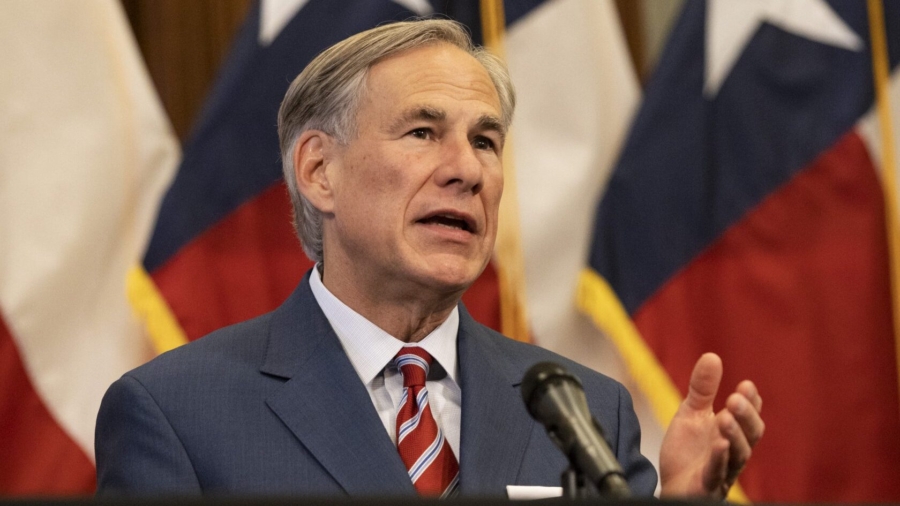Texas Gov. Gregg Abbott gave an update Wednesday on the plan to restore power to the many residents still without electricity or safe drinking water after a brutal cold snap wreaked havoc on the Lone Star state’s power grid and caught utility providers flat-footed.
Power outages in Texas dropped below a half-million on Thursday morning for the first time in four days, down from about 3 million the day before. Around 7 million Texans are still under an advisory to boil drinking water for safety following days of record-low temperatures that damaged infrastructure and froze pipes.
Abbott told a press conference Wednesday that he has ordered natural gas producers in Texas to stop selling fuel outside of the state and to instead supply its power generators in Texas in a bid to restore electricity. He also said more power was being restored to the grid, including via nuclear, coal, and gas-powered generation.
He said around 6,000 megawatts of power had already been added to the grid, and that a nuclear generator and coal power would add another 2,000 megawatts.
“About 1,600,000 homes have had power restored today,” Abbott wrote in a tweet later in the day. “Current power generation is restoring an additional 200,000 homes every hour.”
Mechanical problems or a lack of supply of gas meant that about 19,800 megawatts of gas-powered generation was still offline, Abbott said at the presser. Frozen wind turbines and lack of sun for solar power led to another 17,200 megawatts remaining offline, the governor said.

Plunging temperatures caused Texans to turn up their heaters, including many inefficient electric ones. Demand spiked to levels normally seen only on the hottest summer days, when millions of air conditioners run at full tilt.
The state has a generating capacity of about 67,000 megawatts in the winter compared with a peak capacity of about 86,000 megawatts in the summer. The gap between the winter and summer supply reflects power plants going offline for maintenance during months when demand typically is less intense and there’s not as much energy coming from wind and solar sources.
But those planning for this winter didn’t imagine temperatures cold enough to freeze natural gas supply lines and stop wind turbines from spinning. Earlier on Wednesday, 46,000 megawatts of power were offline statewide—28,000 from natural gas, coal, and nuclear plants and 18,000 from wind and solar, according to the Electric Reliability Council of Texas (ERCOT), the organization that operates the state’s power grid.
ERCOT said Thursday morning that the remaining outages are largely weather-related, rather than forced outages that were made early Monday to stabilize the power grid.
“We will keep working around the clock until every single customer has their power back on,” ERCOT Senior Director of System Operations Dan Woodfin said.

Texas Attorney General Ken Paxton has launched an investigation into the ERCOT, alleging “mishandling” amid the brutal cold snap that left millions of Texans shivering and in the dark.
“ERCOT & other energy cos have slipped & fallen on their faces & it’s not the ice’s fault. They have left 3+ million homes w/o power for days, including my own,” Paxton wrote in a tweet late Wednesday.
“What do they do in response? Jack up prices, go silent, make excuses, & play the blame game. It’s unacceptable!” he added.
The staggering imbalance between Texas’s energy supply and demand caused prices to skyrocket from roughly $20 per megawatt hour to $9,000 per megawatt hour in the state’s freewheeling wholesale power market.
Gas-fired plants and wind turbines can be protected against winter weather—it’s done routinely in colder, northern states. The issue arose in Texas after a 2011 freeze that also led to power-plant shutdowns and blackouts. A national electric-industry group developed winterization guidelines for operators to follow, but they are strictly voluntary and also require expensive investments in equipment and other necessary measures.
ERCOT official Dan Woodfin said plant upgrades after 2011 limited shutdowns during a similar cold snap in 2018, but this week’s weather was “more extreme.”
Ed Hirs, an energy fellow at the University of Houston, rejected ERCOT’s claim that this week’s freeze was unforeseeable.
“That’s nonsense,” he said. “Every eight to 10 years we have really bad winters. This is not a surprise.”
The Associated Press contributed to this report.
From The Epoch Times

